|
Afrocarpus falcatus (Outeniqua
yellowwood, Small-leaved yellowwood) [= Podocarpus falcatus]
Outeniekwageelhout [Afrikaans]; umKoleya, umGeya [Xhosa]; umSonti, umGeya
[Zulu]; umSonti [Swazi]; Mogôbagôba [North Sotho]
Life
> eukaryotes >
Archaeoplastida >
Chloroplastida
>
Charophyta > Streptophytina > Plantae (land plants)
> Tracheophyta (vascular plants) > Euphyllophyta > Lignophyta (woody plants) > Spermatophyta (seed plants)
> Gymnospermae >
Coniferophyta
> Podocarpaceae > Afrocarpus
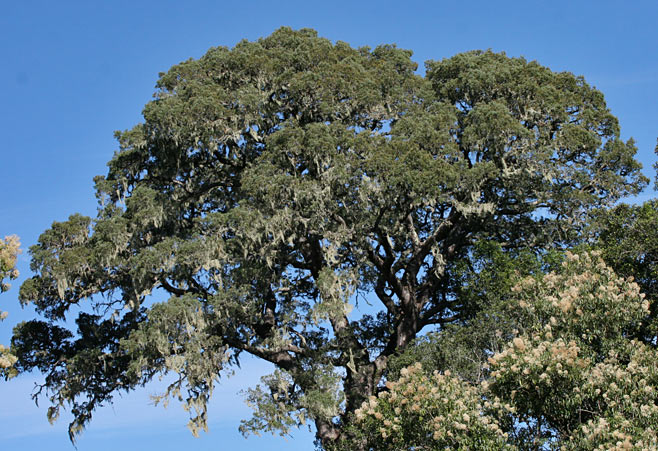 |
|
Crown of a large Outeniqua yellowwood on
Kom-se-Pad, near Knysna, July 2006, festooned with Usnea (old
man's beard) lichen. [photo Duncan Robertson
©] |
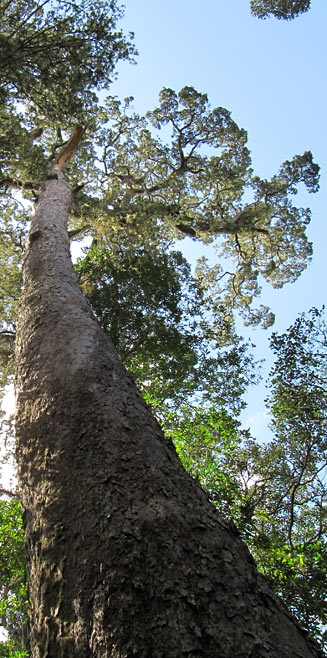 |
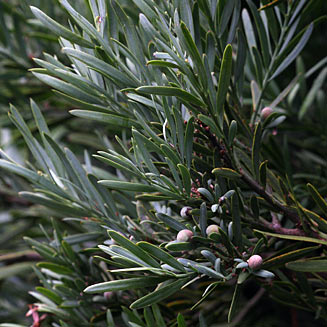 |
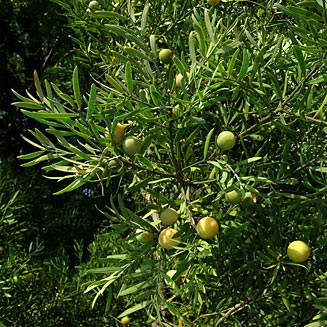 |
|
Afrocarpus falcatus (Outeniqua yellowwood),
Tsitsikamma Hiking Trail, January 2010. [photo H. Robertson
©] |
Afrocarpus
falcatus in fruit at Rondebossie Hut, Outeniqua Hiking Trail, December
2008 (top), and in Kirstenbosch Botanical Gardens, Cape Town, July 2005
(bottom). [photo
H. Robertson, Iziko ©]. |
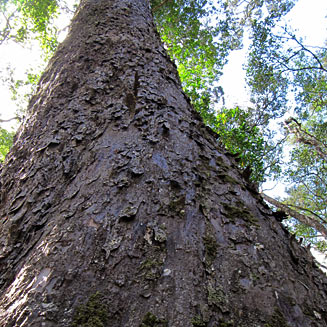 |
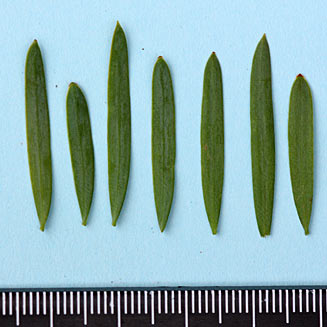 |
|
Trunk of Afrocarpus falcatus, showing
distinctive flaky bark; Tsitsikamma Hiking Trail, January 2010. [photo
H. Robertson ©] |
Leaves of Afrocarpus falcatus. Scale is in
millimeters. |
Regarded as the tallest tree that is native to southern
Africa with trees evidently reaching 60 m in height. The "Big Trees" that are
popular tourist attractions in the Knysna region of the Western Cape and western
Eastern Cape are all Outeniqua yellowwoods. Some of these are featured on a
separate page (see here) but the
tallest of these is only 46 m in height.
Distribution and habitat
Grows in afromontane forest from the Swellendam district of
the Western Cape through to Limpopo and southern Mozambique.
Ecological relationships
 |
|
|
The large size of Outeniqua yellowwoods makes them
an ideal protected place for
Chacma baboons to sleep the night in places where there are no cliff
faces. These baboons were photographed in the evening, preparing noisely
to sleep the night in this tree; Platbos Hut, Outeniqua Hiking Trail,
December 2008. [photo H. Robertson ©] |
|
- Fruit are eaten by:
- The tree is used as:
- a substrate for Usnea (old man's beard) lichens. These
lichens hang down from the branches and are a very distinctive feature
of Afrocarpus falcatus trees.
- a sleeping place at night for
Chacma baboons (see photograph above).
Uses
- The fine-grained, pale yellow wood is used these days mainly for
making furniture and for building boats. In the past it was also used for
floors, ceilings and the masts and yards of ships. The wood tends to have a
spiral grain (see twisting of trunk in photo above), which means that it
tends to warp if it has not been seasoned properly.
- Grown as a garden ornamental tree.
Links
References
- Esterhuyse, N., von Breitenbach, J. and Söhnge, H. 2001. Remarkable
Trees of South Africa. Briza Publications, Pretoria.
- Palgrave, K.C. and Palgrave, M.C. 2002. Trees of Southern Africa. 3rd
Edition. Struik Publishers, Cape Town.
- Palmer, E. and Pitman, N. 1972. Trees of Southern Africa covering all
known indigenous species in the Republic of South Africa, South-West Africa,
Botswana, Lesotho and Swaziland. Volume 1. A.A. Balkema, Cape
Town.
- van Wyk, B. and van Wyk, P. 1997. Field Guide to Trees of Southern
Africa. Struik Publishers, Cape Town.
Text by Hamish Robertson |
